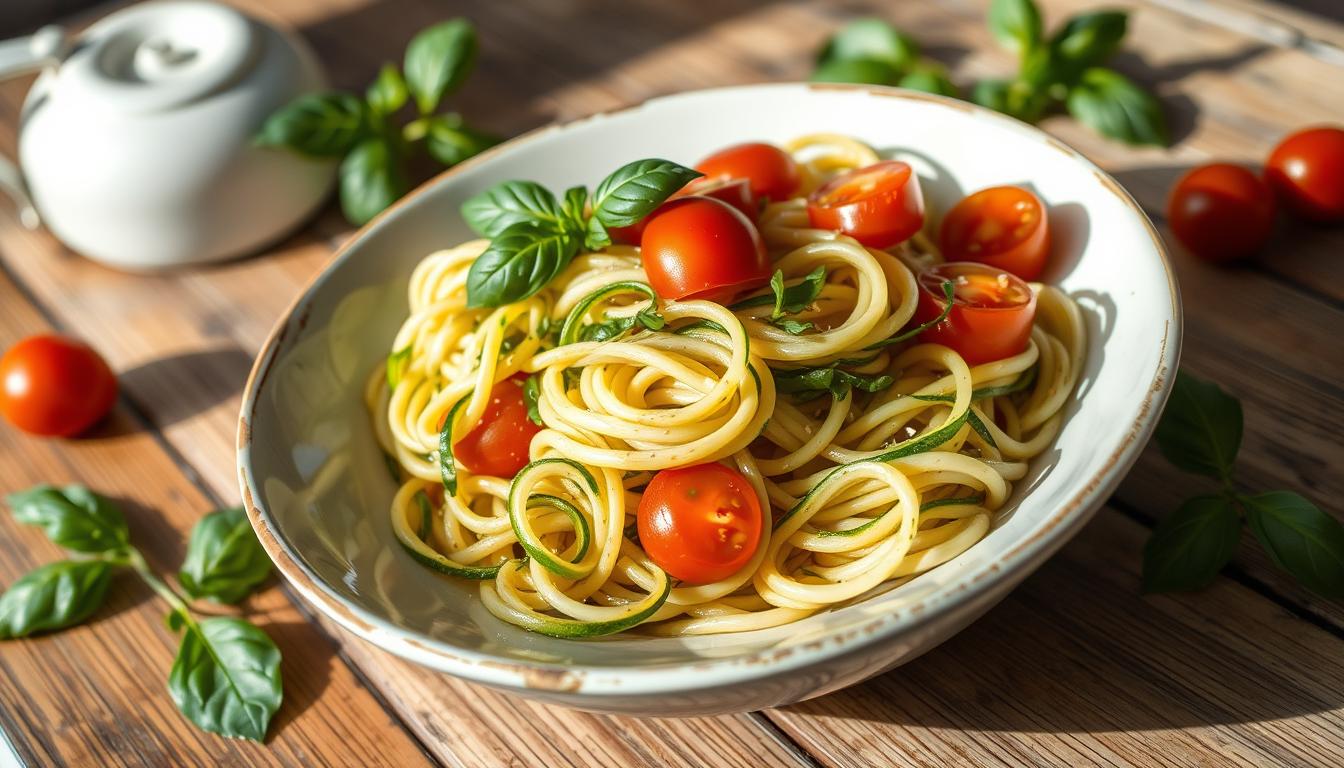Imagine a pasta dish that’s not only tasty but also fits your dietary needs. For those with endometriosis, a healthy, anti-inflammatory diet is key. That’s why we’re thrilled to share our endo friendly gluten-free pasta zucchini recipe. It’s a great choice for a nutritious, satisfying meal instead of regular pasta.
Did you know zucchini noodles cook in just 1 minute? They offer a light, veggie-rich flavor. This quick cooking time means you can enjoy a healthier pasta without losing taste or texture. Plus, they’re packed with nutrients like Omega 3 fats, anti-inflammatory properties, and alkaline components. This low-FODMAP dish is a real winner for managing endometriosis symptoms.
The best part? You can make Gluten-Free Pasta with Zucchini Endo in just 11 minutes. That’s perfect for busy people dealing with endometriosis. Get ready to enjoy a tasty, nourishing meal that’s good for your endometriosis diet and health.
Unleash the Power of Zucchini Noodles
Zucchini noodles, or “zoodles,” are a big hit for those looking for tasty, gluten-free pasta. You can make them by using a spiralizer or julienne peeler. This turns fresh zucchini into long, noodle-like strands that look and feel like real pasta. It’s a fun way to add more nutrients to your meals by spiralizing zucchini.
A Game-Changer for Gluten-Free Pasta Lovers
If you’re gluten-free or prefer low-carb options, zucchini noodles are a great choice. These vegetable noodles are not only tasty but also packed with nutrients. They’re perfect for a variety of sauces and toppings.
Spiralizing: The Art of Creating Veggie Noodles
- Spiralizing zucchini is a simple and efficient way to transform the vegetable into long, ribbon-like strands.
- Using a spiralizer or julienne peeler, you can easily create zucchini noodles that mimic the shape and texture of pasta.
- Experiment with different vegetable varieties, such as carrots, sweet potatoes, or beets, to add visual appeal and unique flavors to your dishes.
Adding zucchini noodles to your meals lets you enjoy pasta’s comforting taste without the gluten or carbs. Explore the world of vegetable noodles and discover the versatility of this ingredient in your kitchen.
Endo Friendly Gluten-Free Pasta Zucchini
The Perfect Low-FODMAP Solution
For those with endometriosis, the gluten-free zucchini pasta recipe is a great choice. Zucchini is low in FODMAPs, making it easy to digest. It’s a good swap for regular pasta, helping with gut health and reducing inflammation.
The diet for endometriosis focuses on fighting inflammation. Endo friendly gluten-free pasta zucchini fits this bill well. It’s full of antioxidants, fiber, and vitamins that help fight inflammation. Also, cutting out gluten can help lessen endometriosis symptoms.
Adding a low-FODMAP diet to your endometriosis care plan is smart. FODMAPs can upset the stomach in people with endometriosis. Choosing low-FODMAP foods like zucchini can ease digestive issues and boost gut health.
https://www.youtube.com/watch?v=akAad5hIbq8
Zucchini noodles are super versatile, making many tasty and anti-inflammatory meals. You can make creamy pasta dishes or stir-fries full of veggies. This endo friendly gluten-free pasta zucchini option lets you enjoy healthy, flavorful meals that meet your dietary needs and help manage endometriosis symptoms.
Zucchini Noodles: A Nutritious Gluten-Free Alternative
Zucchini noodles, or “zoodles,” are a great choice for those avoiding gluten. They are made by spiralizing or thinly slicing fresh zucchini. These veggie noodles are full of vitamins, minerals, and fiber.
They are also low in carbs, unlike traditional pasta. Zucchini noodles have a much lower carb count. This makes them perfect for low-carb or keto diets. Plus, they are gluten-free, which is great for those with celiac disease or gluten intolerance.
Zucchini noodles are very versatile. You can use them in many pasta dishes, like tomato-based sauces or creamy alfredo. They also work well in stir-fries, soups, and cold salads. This makes them a great base for your meals.
If you want to eat more veggies or need a gluten-free pasta option, try zucchini noodles. They have a soft texture and mild taste. They can easily replace traditional pasta in your favorite dishes, making your meals healthier and more enjoyable.
Mastering the Art of Zucchini Pasta
Learning to make zucchini pasta is a skill that takes practice. But with the right tips, we can make our dishes even better. This guide will help us create tasty and satisfying zucchini pasta.
Preparation Tips and Tricks
To make perfect zucchini pasta, follow these tips:
- Spiralizing Technique: Use a good spiralizer for long, uniform noodles. Don’t overdo it, or the pasta will be too wet.
- Zucchini Selection: Pick firm, fresh zucchinis. Avoid ripe or watery ones to keep the pasta crunchy.
- Moisture Control: Pat the noodles dry with a paper towel after spiralizing. This removes extra moisture.
- Cooking Technique: Cook the noodles quickly in a hot pan with a bit of oil. This keeps them crisp.
- Seasoning: Try different herbs, spices, and seasonings to add flavor. Options like garlic, basil, lemon, and pepper are great.
| Cookbook Title | Author | Kickstarter Funding | Release |
|---|---|---|---|
| Unforgettable: The Bold Flavors of Paula Wolfert’s Renegade Life | Emily Kaiser Thelin | $91,465 from 1,112 backers | 2017 |
| Gather: Everyday Seasonal Food from a Year in Our Landscapes | Gill Meller | N/A | 2022 (US Release) |
| Vibrant India: Fresh Vegetarian Recipes from Bangalore to Brooklyn | Chitra Agrawal | N/A | 2017 |
| Burma Superstar: Addictive Recipes from the Crossroads of Southeast Asia | Desmond Tan and Kate Leahy | N/A | 2017 |
| The Malaysian Kitchen: 150 Recipes for Simple Home Cooking | Christina Arokiasamy | N/A | 2018 |
By following these tips, we can make zucchini pasta that’s tasty, textured, and a great gluten-free option.
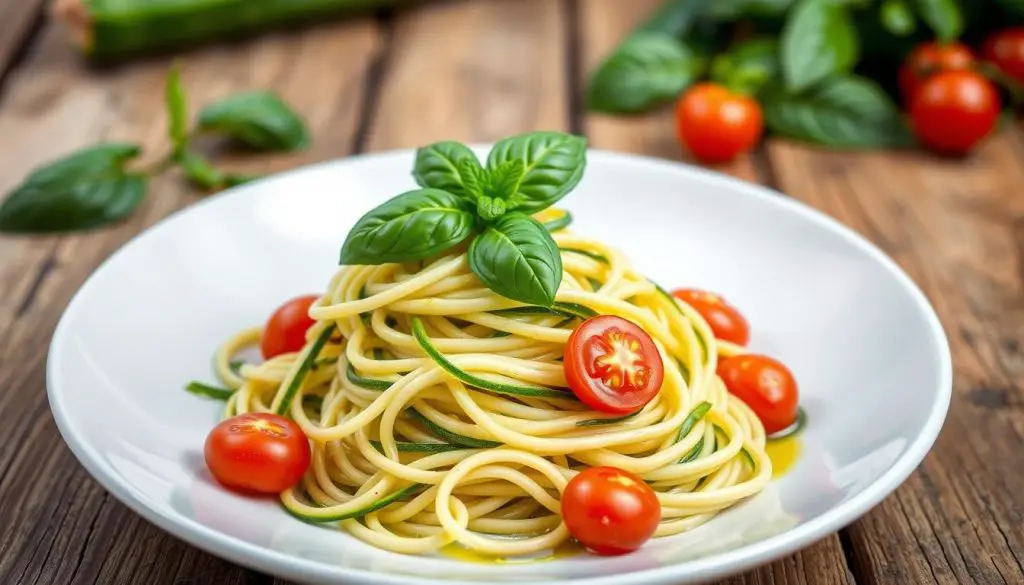
Gluten-Free Zucchini Pasta Recipes to Try
If you’re craving pasta but need to avoid gluten, zucchini noodles are a great choice. They’re gluten-free and good for those with endometriosis. Try these tasty gluten-free zucchini pasta recipes to see how versatile they are.
The Greek Zucchini Pasta Salad is a favorite of ours. It’s made with chickpea pasta, zucchini, feta, garbanzo beans, walnuts, and fresh herbs. It’s also dairy-free and full of flavor and nutrients.
| Nutrition Facts (per serving) | Value |
|---|---|
| Calories | 386 kcal |
| Carbohydrates | 50 g |
| Protein | 13 g |
| Fat | 17 g |
| Fiber | 10 g |
| Sugar | 11 g |
| Sodium | 1361 mg |
| Vitamin A | 1911 IU |
| Vitamin C | 57 mg |
| Calcium | 93 mg |
| Iron | 4 mg |
The Zucchini Noodle Casserole is another great choice. It’s dairy-free and has zucchini noodles, garbanzo beans, and walnuts. Add guacamole, avocado, cashew cream, salsa, or vegan sour cream for a full meal.
Try these gluten-free zucchini pasta recipes and see how versatile they are. They’re perfect for a gluten-free diet or just a healthy pasta option. These recipes will quickly become favorites in your home.
The Benefits of a Gluten-Free Diet for Endometriosis
Starting a gluten-free diet can greatly help those with endometriosis. It removes gluten, which can cause inflammation and gut problems. This diet can help manage symptoms and improve health.
It’s also important to understand the link between the gut and endometriosis. Keeping the gut healthy is key to reducing pain and discomfort from endometriosis.
Understanding the Gut-Endo Connection
Many studies highlight the gut’s role in managing endometriosis. A gluten-free diet can lower inflammation and improve nutrient absorption. These are key for those with endometriosis.
By supporting a healthy gut, a gluten-free diet may lessen symptoms. This includes pelvic pain, heavy bleeding, and digestive issues.
Also, a gluten-free diet filled with anti-inflammatory foods is great for managing endometriosis. Foods like leafy greens, berries, and healthy fats can fight chronic inflammation. This may reduce the need for medication and improve life quality.
Gluten Intolerance and Its Impact on Endometriosis
People with endometriosis often face challenges from gluten intolerance. This can be due to celiac disease or non-celiac gluten sensitivity. Studies show that eating gluten can worsen endometriosis symptoms. This includes more inflammation, hormonal issues, and trouble getting pregnant.
Celiac disease, a serious autoimmune disorder, is becoming more common worldwide. Gluten is linked to over 300 health problems, including cancer and depression. Actress Jennifer Esposito has spoken out about the difficulty in diagnosing and treating celiac disease.
Even without celiac disease, gluten can cause inflammation. This can make endometriosis symptoms worse. Eating zucchini noodles and other gluten-free foods can help manage endometriosis. It also avoids the inflammation caused by gluten.
Research also links the human microbiome to endometriosis. The microbiome is affected by what we eat, including gluten. By avoiding gluten, people with endometriosis might see symptom relief. This could also help with fertility and reproductive health.
It’s important to understand how gluten intolerance affects endometriosis. A gluten-free diet and other anti-inflammatory measures can help. These steps can help people with endometriosis regain control over their health.
Maximizing Nutrient Absorption with Gluten-Free Alternatives
For those with endometriosis, switching to a gluten-free diet is key. It’s important to focus on getting the most nutrients from our food. This is because endometriosis can lead to malnutrition and a lack of important vitamins and minerals.
Looking for foods that are both gluten-free and packed with nutrients is essential. These foods help keep our gut healthy and reduce inflammation.
Plant lectins, phytic acid, and oxalates can block nutrient absorption. For example, raw beans have a lot of lectins. But, soaking, sprouting, and cooking beans can lower these antinutrients. This makes beans and other gluten-free grains easier to digest and more nutritious.
Adding vitamin C-rich foods to our meals can also help. This improves iron and zinc absorption. Garlic, onions, and fermented foods can further increase mineral availability. These steps help us get the most from our gluten-free diet.
It’s also important to eat a variety of colorful fruits and vegetables. Adding healthy fats like fatty fish, nuts, and seeds is beneficial too. These foods are full of phytochemicals and anti-inflammatory compounds that support our health and help manage endometriosis symptoms.
By choosing and preparing gluten-free alternatives wisely, we can improve nutrient absorption. This helps our bodies meet their needs and eases the challenges of endometriosis.
| Nutrient Absorption Strategies | Benefits |
|---|---|
| Soaking, sprouting, and cooking beans and grains | Reduces antinutrients like lectins and phytic acid, improving bioavailability of nutrients |
| Pairing gluten-free foods with vitamin C-rich foods | Enhances iron and zinc absorption |
| Adding garlic, onions, and fermented foods | Boosts mineral bioavailability |
| Incorporating a variety of colorful fruits and vegetables | Provides a wealth of phytochemicals and anti-inflammatory compounds |
| Consuming fatty fish, nuts, and seeds | Supplies healthy fats with anti-inflammatory properties |
The Importance of a Low-FODMAP Diet for Endometriosis
For those with endometriosis, a low-FODMAP diet can be a big help. It helps manage stomach problems and lowers inflammation. This diet removes certain carbs that can cause bloating, gas, and pain in the belly.
Choosing low-FODMAP foods can improve gut health and lessen endometriosis pain. Studies show that eating more fiber can help by lowering estrogen levels. Try to get 25-30 grams of fiber daily from foods like whole grains, beans, and fruits.
Also, eating omega-3 fats from fatty fish and spices like turmeric can slow down endometrial cell growth. Foods high in antioxidants, like berries and dark chocolate, can also help fight inflammation.
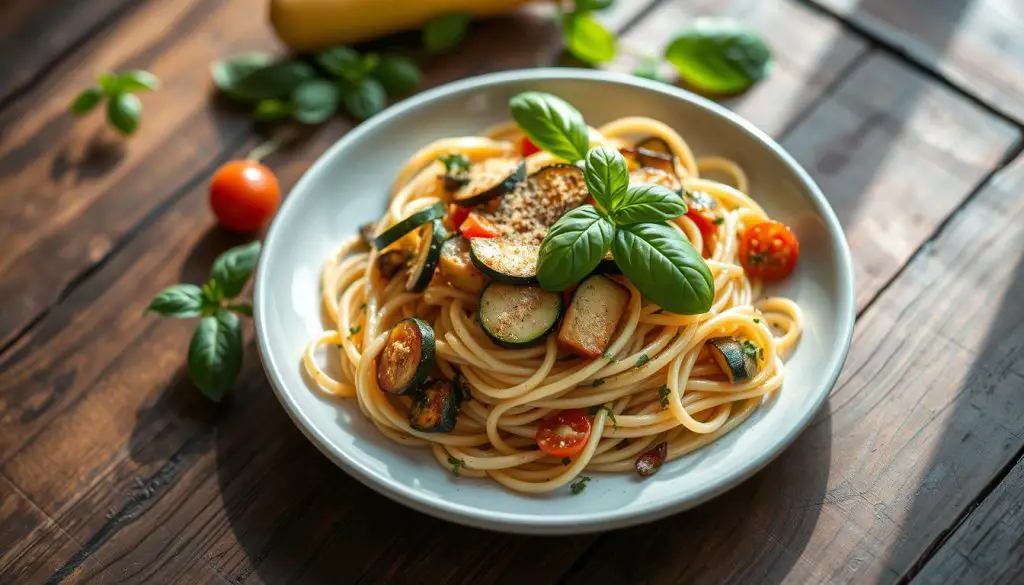
Following a low-FODMAP diet is a key step for managing endometriosis. It helps improve gut health and reduces the condition’s impact. Eating foods that are good for you and fight inflammation is a big part of managing endometriosis.
Overcoming the Challenges of Going Gluten-Free
Starting a gluten-free diet can seem tough, even more so with endometriosis. But, with the right steps and habits, you can make it work. This diet can help manage your condition well.
Practical Tips and Strategies
Finding gluten-free versions of your favorite foods can be hard. Instead of trying to make every dish gluten-free, look for gluten-free alternatives that are endometriosis-friendly. Try zucchini noodles instead of pasta or use gluten-free flour in baking.
Changing your diet should be done slowly. Big changes can be too much and hard to keep up. Start with small steps, making these changes part of your lifestyle. This way, you can build sustainable habits and feel less stressed.
Also, don’t be afraid to ask for help. Talk to healthcare professionals, join online communities, or use gluten-free cookbooks. They offer great advice, recipes, and tips to help you through this change.
Remember, going gluten-free is a journey. It might take time to find what works best for you. Be patient, try new things, and celebrate your successes. With determination and a positive attitude, you can face the challenges and enjoy a gluten-free lifestyle that helps with your endometriosis.
Exploring Gluten-Free Flour Alternatives
If you have endometriosis and love baked goods, finding gluten-free flours is key. We’ll look at flours like almond flour, coconut flour, and cassava. These can replace wheat flour in your recipes. This way, you can keep enjoying your favorite dishes while following a diet that’s good for your health.
Many gluten-free foods are sold in stores, showing they’re popular. But, some people find it hard to stick to a gluten-free diet. This is because there’s a lot of confusion about what foods are safe to eat.
To make things easier, try using flours like coconut, almond, tapioca, and arrowroot. These are becoming more common in baking and cooking. A natural, less processed gluten-free diet is also better for your health and wallet. It shows people want cleaner, nutrient-dense options in the gluten-free market.
| Gluten-Free Flour Alternative | Key Characteristics |
|---|---|
| Almond Flour | Nutrient-dense, high in healthy fats and protein, suitable for baking |
| Coconut Flour | High in fiber, low in carbs, adds moisture and texture to baked goods |
| Cassava Flour | Versatile, mild flavor, can be used as a 1:1 substitute for wheat flour |
Using these gluten-free flour alternatives opens up new cooking possibilities. You can keep making your favorite baking and cooking dishes. The important thing is to try different flours until you find the right mix for your taste and diet.
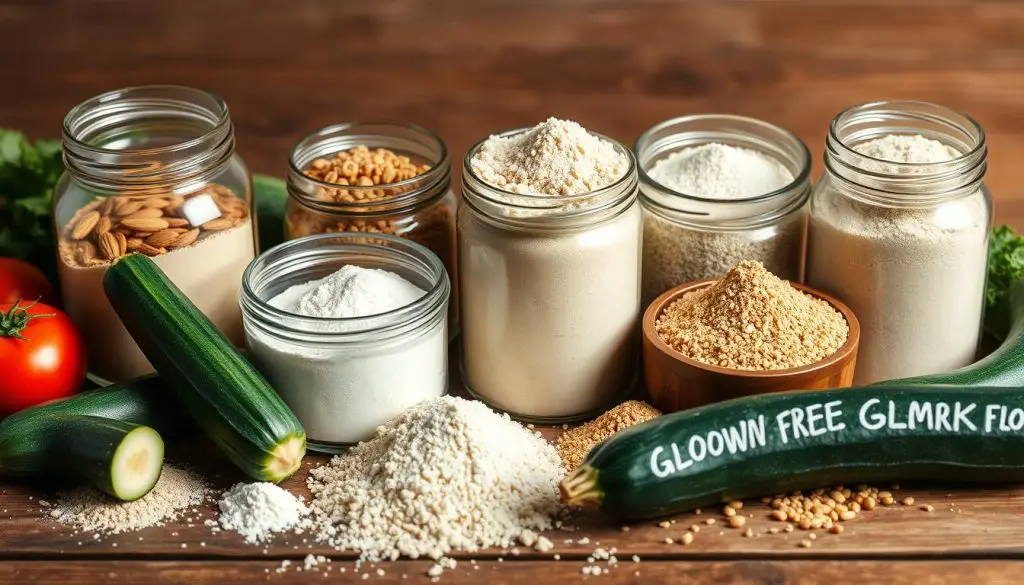
Anti-Inflammatory Foods for Endometriosis Management
Managing endometriosis needs a mix of approaches, and eating anti-inflammatory foods is key. This condition causes chronic inflammation due to uterine-like tissue outside the uterus. Eating foods rich in nutrients and anti-inflammatory properties can help ease symptoms and improve health.
Research shows that some foods can make endometriosis worse. Avoiding red meat, dairy, sugars, gluten, and processed carbs is important. On the other hand, eating foods that fight inflammation can help manage the condition.
Some top anti-inflammatory foods for endometriosis include:
- Leafy green vegetables, such as spinach, kale, and collard greens, which are packed with antioxidants and fiber.
- Fatty fish, like salmon, mackerel, and sardines, which are high in omega-3 fatty acids.
- Turmeric, a spice renowned for its potent anti-inflammatory properties due to its active compound, curcumin.
- Berries, such as blueberries and cherries, which are rich in anthocyanins that possess anti-inflammatory effects.
- Ginger, a versatile ingredient that can help reduce inflammation and alleviate pain.
- Healthy fats, such as those found in avocados, nuts, and olive oil, which can help decrease inflammation.
Eating these foods can help manage endometriosis and support gut health. Working with a registered dietitian can help create a diet plan that fits our needs and preferences.
| Anti-Inflammatory Foods | Key Benefits for Endometriosis |
|---|---|
| Leafy greens | Rich in antioxidants and fiber, helping to reduce inflammation. |
| Fatty fish | High in omega-3 fatty acids, which have potent anti-inflammatory properties. |
| Turmeric | Contains curcumin, a compound with strong anti-inflammatory effects. |
| Berries | Packed with anthocyanins, which possess anti-inflammatory and pain-relieving benefits. |
| Ginger | Helps reduce inflammation and alleviate pain associated with endometriosis. |
| Healthy fats | Can help decrease inflammation and support overall gut health. |
Incorporating Zucchini Noodles into Your Meal Plan
Zucchini noodles, or “zoodles,” are a great choice for anyone with endometriosis. They are gluten-free and can be used in many dishes. From pasta to salads and stir-fries, zucchini noodles add variety and nutrition to your meals.
Versatile Recipes for Every Occasion
Zucchini noodles are perfect for those who follow a gluten-free or low-carb diet. Here are some tasty recipes to try:
- Zucchini Noodle Bolognese – A classic Italian dish with zucchini noodles, ground turkey, and tomato sauce.
- Zucchini Noodle Stir-Fry – Sautéed zucchini noodles with protein, veggies, and gluten-free sauce.
- Zucchini Noodle Caprese Salad – Zucchini noodles with tomatoes, mozzarella, basil, and balsamic vinaigrette.
- Zucchini Noodle Pad Thai – A twist on the Thai dish, with zucchini noodles, shrimp, peanuts, and sweet sauce.
Adding zucchini noodles to your meals can make your diet healthier and tastier. Try out different recipes to find your favorite zucchini noodle dishes.
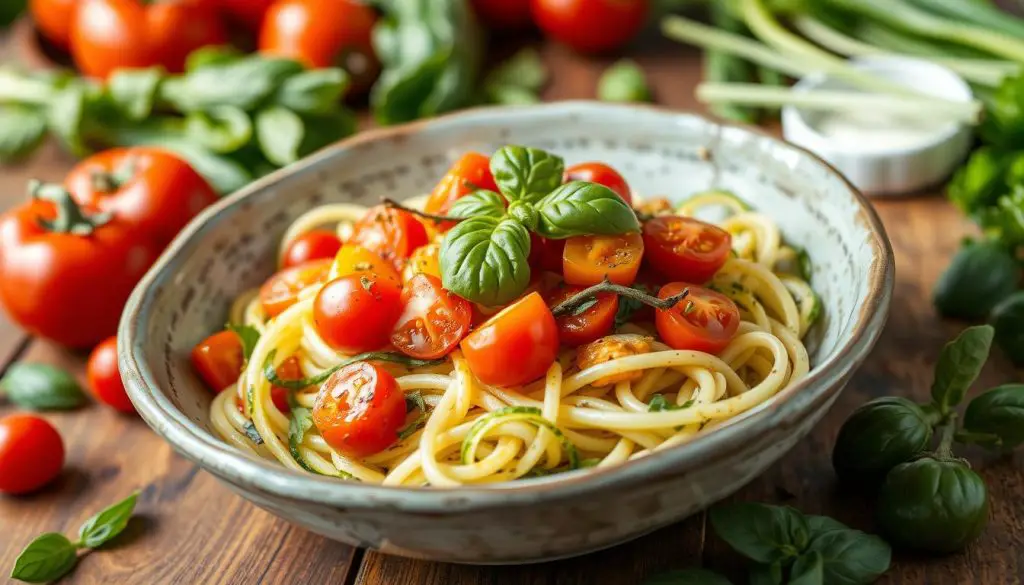
The Endometriosis Diet: A Holistic Approach
Adopting a holistic approach to the endometriosis diet is key for managing the condition. It involves eating nutrient-dense, anti-inflammatory foods that help gut health. This way, we tackle the root causes of endometriosis symptoms and find a lasting solution.
The heart of the endometriosis diet is nourishing our bodies with natural ingredients. Foods like steamed zucchini, rocket, salmon, avocado, bone broth, and coconut oil are powerful. They help reduce inflammation, balance hormones, and boost overall health. Eating these foods helps us manage endometriosis symptoms effectively.
A holistic diet also focuses on gut health. It aims to improve nutrient absorption and support healing. This approach goes beyond just avoiding gluten, dairy, or soy. It offers real relief for those with endometriosis.
Source Links
- https://kugeu.org/creamy-garlic-and-tuna-zucchini-noodles-paleo-gf/
- https://endofertilityspecialist.com/spinach-avocado-and-nut-pesto-pasta/
- https://happyherbivore.com/blog/archive/
- https://drkathleenmahannah.com/blog/endometriosis-foods-to-eat-and-avoid
- https://www.endo-resolved.com/endometriosis-diet-basics.html
- https://www.verywellhealth.com/endometriosis-diet-7105372
- https://thehumbledhomemaker.com/healthy-low-carb-pasta-alternatives/
- https://downshiftology.com/recipes/paleo-zucchini-bread/comment-page-3/
- https://www.healthline.com/nutrition/grain-free-diet
- https://www.eatyourbooks.com/blog/2017/03/27/march-2017-cookbook-roundup
- https://www.abbeyskitchen.com/vegan-taco-casserole/
- https://themigonikitchen.com/zucchini-pasta-salad-with-lemon-feta-and-garbanzo-beans/
- https://www.abbeyskitchen.com/diet-for-endometriosis/
- https://www.everydayhealth.com/diet-nutrition/endomorph-diet/
- https://support.doctorpodcasting.com/client/upmc/itemlist/tag/Gluten Free
- https://www.pricelessrd.com/blogposts
- https://culinahealth.com/healing-carrot-ginger-soup/
- https://www.mdpi.com/2304-8158/12/5
- https://thyroidpharmacist.com/articles/best-diet-for-hashimotos-hypothyroidism/
- http://www.chewfo.com/diets/the-20-20-diet-by-dr-phil-mcgraw-food-list-what-to-eat-and-foods-to-avoid/
- https://drkellyann.com/blogs/news/slcilekbegs703u9s986o1w9i5nj84?srsltid=AfmBOora4OVLgt_653h5Nxr695Y4bkSAtGL6x4esW_1Uxic48ZGd-jYO
- https://www.everydayhealth.com/diet-nutrition/gluten-free-diet/
- https://artofglutenfreebaking.com/the-story-behind-my-gluten-free-flour-mix/
- https://www.endo-resolved.com/anti_inflammatory_diet.html
- https://www.usenourish.com/blog/4-week-gut-protocol-meal-plan
- https://www.julienutrition.com/introduce-vegetables-diet/
- https://www.aol.com/youre-trying-eat-more-low-130000840.html
- https://aimeeraupp.com/38-years-old-finally-brought-home-a-healthy-baby-after-too-many-miscarriages/
- https://itsalifestylehun.com/health-wellness/3-natural-pain-relief-products-if-you-suffer-from-endometriosis/
- https://biomedome.wordpress.com/
